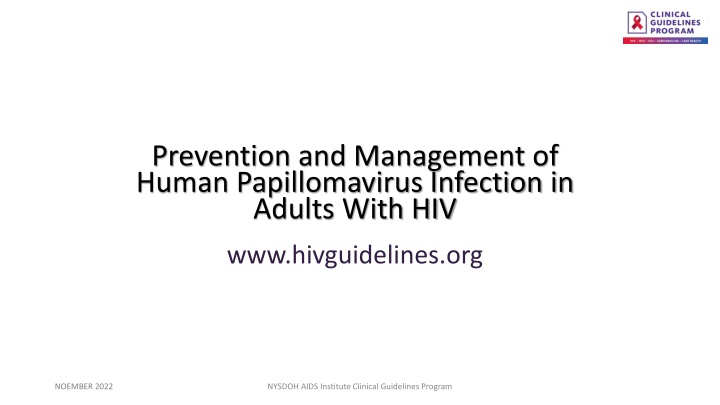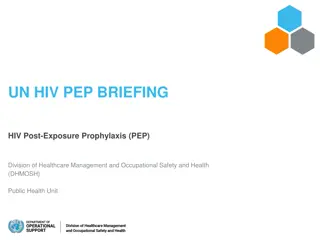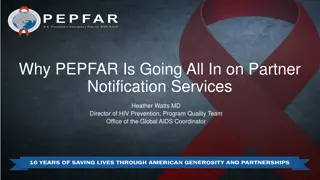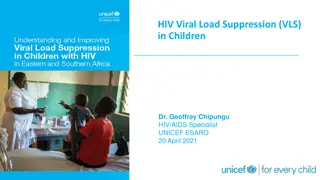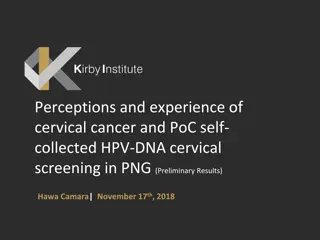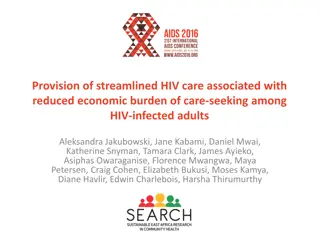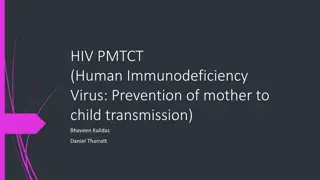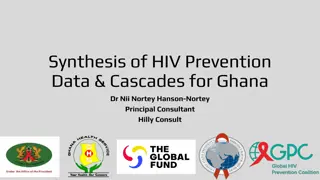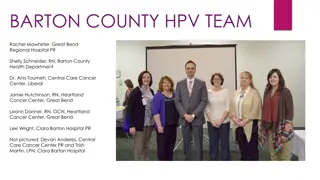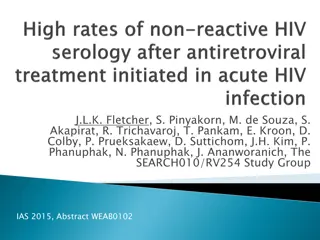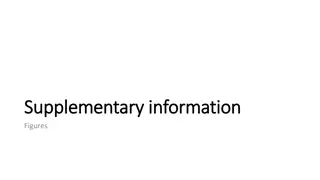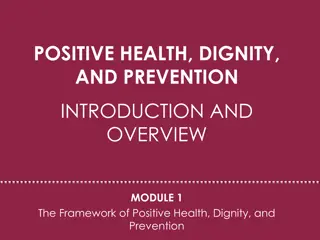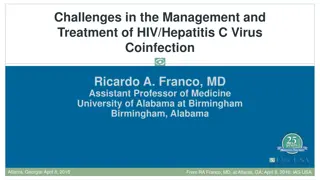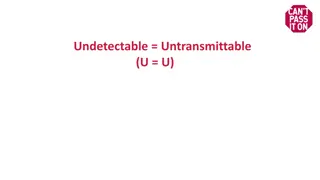Prevention and Management of HPV in Adults With HIV
This guideline focuses on increasing screening and treatment for HPV-related dysplasia in individuals with HIV to reduce morbidity and mortality. Recommendations include HPV vaccination and regular cervical and anal cancer screenings for this population.
Download Presentation

Please find below an Image/Link to download the presentation.
The content on the website is provided AS IS for your information and personal use only. It may not be sold, licensed, or shared on other websites without obtaining consent from the author.If you encounter any issues during the download, it is possible that the publisher has removed the file from their server.
You are allowed to download the files provided on this website for personal or commercial use, subject to the condition that they are used lawfully. All files are the property of their respective owners.
The content on the website is provided AS IS for your information and personal use only. It may not be sold, licensed, or shared on other websites without obtaining consent from the author.
E N D
Presentation Transcript
Prevention and Management of Human Papillomavirus Infection in Adults With HIV www.hivguidelines.org NOEMBER 2022 NYSDOH AIDS Institute Clinical Guidelines Program
Purpose of This Guideline Purpose of This Guideline Increase the number of New York State residents with HIV who are screened and effectively treated for HPV-related dysplasia. Support the NYSDOH Prevention Agenda 2019-2024 by educating care providers on the importance of HPV vaccination and increasing the rate of 3-dose HPV immunization among individuals with HIV. Reduce the morbidity and mortality associated with HPV in people with HIV through early identification and treatment of potentially precancerous and cancerous lesions, when treatment is most likely to be effective. NOVEMBER 2022 NYSDOH AIDS Institute Clinical Guidelines Program www.hivguidelines.org
Recommendation: Recommendation: HPV Prevention HPV Prevention Given the increased lifetime risk of persistent human papillomavirus (HPV) infection and increased prevalence of HPV-related cancers, clinicians should recommend the 9-valent HPV vaccine 3-dose series at 0, 2, and 6 months to all individuals with HIV who are 9 to 45 years old regardless of CD4 cell count, prior cervical or anal screening results, HPV test results, HPV-related cytologic changes, or other history of HPV-related lesions. (A3) NOVEMBER 2022 NYSDOH AIDS Institute Clinical Guidelines Program www.hivguidelines.org
Key Points: Key Points: HPV Prevention HPV Prevention HPV testing is not recommended before administration of the HPV vaccine. Inform patients with HIV about the risk of acquiring HPV and other STIs from close physical contact with the external genitalia, anus, cervix, vagina, urethra, mouth and oral cavity, or any other location where HPV lesions are present. Consistent and correct condom use remains an effective way to prevent the transmission of most STIs, including HPV. However, inform patients that barrier protection such as condoms and dental dams may not fully protect against HPV. NOVEMBER 2022 NYSDOH AIDS Institute Clinical Guidelines Program www.hivguidelines.org
Recommendations: Recommendations: Cervical and Anal Cancer Screening Cervical and Anal Cancer Screening Clinicians should perform cervical and anal cytologic screening for individuals with HIV, regardless of their HPV vaccination status. (A3) Clinicians should examine the neovagina in transgender women who have undergone vaginoplasty to assess for visible HPV lesions at baseline and during the annual comprehensive physical examination; examination can be done using an anoscope, a small vaginal speculum, or a nasal speculum. (A3) At each routine monitoring visit, clinicians should ask all patients about sexual behaviors and new sex partners to assess for risk behaviors that require repeat or ongoing screening. (A3) NOVEMBER 2022 NYSDOH AIDS Institute Clinical Guidelines Program www.hivguidelines.org
Key Points: Key Points: Cervical and Anal Cancer Screening Cervical and Anal Cancer Screening Regardless of cytology results, it is important that screening for STIs is performed routinely in patients who engage in risk behaviors. Assessment for visible HPV lesions in individuals with HIV can be accomplished through baseline and then annual examination of the periurethral and anogenital areas and the vagina and cervix. NOVEMBER 2022 NYSDOH AIDS Institute Clinical Guidelines Program www.hivguidelines.org
Recommendations: Recommendations: Presentation and Diagnosis of HPV Infection Presentation and Diagnosis of HPV Infection Clinicians with limited expertise should refer patients with abnormal anogenital physical findings, such as warts, hypopigmented or hyperpigmented plaques/lesions, lesions that bleed, or any other lesions of uncertain etiology, for expert evaluation, which may include colposcopy, HRA, or biopsy. (A3) Clinicians should maintain a low threshold for obtaining biopsies of lesions that are atypical in appearance; condylomatous; hypopigmented, hyperpigmented, or variegated; or that fail to respond to standard treatment. (A3) Clinicians should conduct or refer patients with abnormal cervical or anal cytology results for colposcopy, HRA, or biopsy. (A3) Clinicians should refer individuals with visible urethral lesions to a urologist experienced in HPV biopsy and diagnosis. (A3) Clinicians should diagnose, treat, and follow up on HPV-related lesions in patients with HIV in consultation with a clinician experienced in the management of HPV and HIV. (A3) NOVEMBER 2022 NYSDOH AIDS Institute Clinical Guidelines Program www.hivguidelines.org
Key Points: Key Points: Presentation and Diagnosis of HPV Infection Presentation and Diagnosis of HPV Infection Cervical and anogenital symptoms of HPV-associated disease include itching, bleeding, pain, or spotting after sexual intercourse. Consider HPV-associated disease in the differential diagnosis when symptoms are present. Failure to correctly diagnose precancerous or cancerous HPV-related disease in a timely manner can delay therapy and possibly lead to mortality. Therefore, maintain a low threshold for obtaining biopsies of lesions that are atypical in appearance, are condylomatous, have variegated pigmentation, or that fail to respond to standard treatment. NOVEMBER 2022 NYSDOH AIDS Institute Clinical Guidelines Program www.hivguidelines.org
Recommendations: Recommendations: HPV Treatment HPV Treatment Clinicians should not use sinecatechins in patients with HIV. (A3) Clinicians should obtain a biopsy to exclude dysplasia or cancer for condyloma that have not responded to treatment. (A3) Clinicians should switch treatment modalities if biopsy-confirmed warts or condyloma have not improved substantially within 4 months of therapy. (A3) Clinicians should refer patients with lesions that are resistant to topical therapies; that change in appearance; that have ulceration, irregular shape, or variegated pigmentation; or with biopsy- proven dysplasia to clinicians experienced in the management of HPV and HIV. (A3) Clinicians should refer patients with visible urethral lesions to a urologist for treatment. (A3) Clinicians should refer patients with HIV who have anogenital cancer to an oncologist for treatment. (A3) Clinicians should avoid the use of imiquimod in pregnant individuals unless the benefits outweigh the risk. (A3) Clinicians should not use sinecatechins, podophyllin, or podofilox (podophyllotoxin) in pregnant individuals. (A3) NOVEMBER 2022 NYSDOH AIDS Institute Clinical Guidelines Program www.hivguidelines.org
Available Treatment Options for Anogenital Available Treatment Options for Anogenital Condyloma for Patients With HIV Condyloma for Patients With HIV Condyloma Type Treatment Comments Cryotherapy with liquid nitrogen or cryoprobe Surgical excision TCA or BCA 80% 90% solution Patient self-administered treatments: Imiquimod 3.75% or 5% cream Podofilox 0.5% solution or gel Use for external anogenital warts, including warts on penis, groin, scrotum, vulva, perineum, external anus, and perianus. Patients with external anal or perianal warts may also have intra-anal warts and therefore might benefit from inspection of the anal canal by digital examination or anoscopy (standard or high resolution). Imiquimod may weaken condoms and vaginal diaphragms. Anogenital condyloma Cryotherapy with liquid nitrogen Surgical excision -- Urethral meatus condyloma Cryotherapy with liquid nitrogen Surgical excision TCA or BCA 80% 90% solution Cryoprobe use in the vagina is not recommended because of the risk of vaginal perforation and fistula formation. Vaginal condyloma NOVEMBER 2022 NYSDOH AIDS Institute Clinical Guidelines Program www.hivguidelines.org
Available Treatment Options for Anogenital Available Treatment Options for Anogenital Condyloma for Patients With HIV, Condyloma for Patients With HIV, continued continued Condyloma Type Treatment Comments Cryotherapy with liquid nitrogen Surgical excision TCA or BCA 80% 90% solution Management of cervical warts should include consultation with a specialist. For patients who have exophytic cervical warts, a biopsy evaluation to exclude high-grade squamous intraepithelial lesions must be performed before treatment is initiated. Cervical condyloma Cryotherapy with liquid nitrogen Surgical excision TCA or BCA 80% 90% solution Cryotherapy with liquid nitrogen or cryoprobe Surgical excision TCA or BCA 80% 90% Patient self-administered treatments: Imiquimod 3.75% or 5% cream Podofilox 0.5% solution or gel Management of intra-anal warts should include consultation with a colorectal specialist. Intra-anal condyloma Imiquimod may weaken condoms and vaginal diaphragms. Neovaginal condyloma NOVEMBER 2022 NYSDOH AIDS Institute Clinical Guidelines Program www.hivguidelines.org
Recommendation: Recommendation: Partner Exposure to HIV and HPV Partner Exposure to HIV and HPV When a patient with HIV is diagnosed with HPV, clinicians should advise the patient to encourage sex partners to seek evaluation for possible exposure to both HPV and HIV. (A3) Key Points: The local health department may contact a sex partner confidentially about a potential HIV exposure and treatment options. Counsel patients about partner notification, risk reduction, and safer sex practices. NOVEMBER 2022 NYSDOH AIDS Institute Clinical Guidelines Program www.hivguidelines.org
New York State Law: New York State Law: Partner Exposure to HIV and HPV Partner Exposure to HIV and HPV New York State Public Health Law requires that medical providers talk with individuals with HIV about their options for informing their sex partners that they may have been exposed to HIV, including the free, confidential partner notification assistance offered by the NYSDOH and New York City Department of Health and Mental Hygiene. NOVEMBER 2022 NYSDOH AIDS Institute Clinical Guidelines Program www.hivguidelines.org
Need Help? Need Help? NYSDOH AIDS Institute Clinical Guidelines Program www.hivguidelines.org
Access the Guideline Access the Guideline www.hivguidelines.org > Prevention and Management of Human Papillomavirus Infection in Adults With HIV Also available: Printable pocket guide and PDF NYSDOH AIDS Institute Clinical Guidelines Program www.hivguidelines.org
